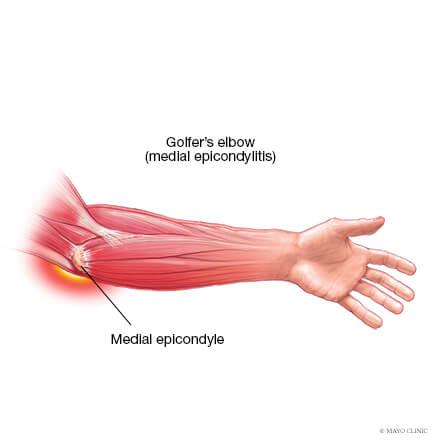
Golfer's Elbow
Medial epicondylitis is another name for golfer's elbow, which is a condition where tiny tears form in the tendons that surround your elbow. Overuse of the forearm muscles or improper form in sports like baseball, racquet sports, weight training, golf, or other throwing sports are the usual causes of this injury.
Overview
When someone has a golfer's elbow, a type of tendinitis, the tendons that connect the forearm to the elbow become inflamed and painful. The inside bony bump of your elbow is the source of the pain, which may also radiate into your forearm. The right elbow is the most common location for a golfer's elbow in a novice right-handed golfer. Individuals suffering from the illness frequently shift their weight incorrectly and tend to "throw the club down" when hitting the ball.
This is sometimes referred to as "hitting from the top." As a result, the muscles in the forearm may become more stressed. The pronator teres an inner forearm muscle, which is especially active during the acceleration phase of the swing. Golfer's elbow can occur in the left arm of right-handed golfers if the follow-through is created by turning the wrist. The golfer's wrist turns palm up in these situations, putting additional strain on the inner side of the left elbow.
Causes
The most common cause of a golfer's elbow is overuse of the forearm muscles, which all golfers.
Any repetitive motions with your hands, wrists, or forearms can result in a golfer's elbow you to grip rotate, and flex your wrist. Contrary to its name, this illness affects more people than just g.
Sports like tennis, require a racket: Golfer's elbow can also result from using a racket that is too light or heavy.
Sports involve a lot of throwing motions: softball, baseball, football, archery, baseball, and bowling. Golfer's elbow can affect those who work in construction, such as carpenters painters plumbers, and other tradespeople.
A lot of repetitive, forceful motions like lifting weights incorrectly. Individuals could also develop the condition by using tools like hammers, screwers, and others.
Symptoms
Among the more typical signs of a golfer's elbow are:
Discomfort from your elbow to your wrist on the inside of your forearm. Usually, this pain is located on the same arm side as your little finger.
Experiencing pain when you flex your wrist with your palm facing down.
Pain experienced during a handshake.
A feeble hold.
Your pinkie and ring fingers experience tingling and numbness that extends from your elbow.
Pain that intensifies when you flex your wrist or grasp objects.
Ayurvedic View
Asthi vaha sroto dushti- it's a condition where there is mainly involvement of kandara (tendon) along with prakupita (aggravated) vata dosha in elbow area- sandhi pradesha (joint forming structures), which results in adika shoola (severe pain), aankunchana prasarana kashta chesta (pain) and restrictions while extension and flexion movements, this is golfer's elbow, when there is pain in medial or inner side of elbow. Ayurveda's approach is to reduce the symptoms and quicker healing by bringing dosha back to prakruta awastha (balance state), thereby increase range of movement of the affected joint, nourish the dhatus (strengthen tissue) by ayurvedic panchakarma treatment.
Ayurvedic Treatments
Lepanam Churna pinda swedanam Pinda swedanam Navara pinda Swedanam Upanaham Nadi swedanam Kashaya dhara
Naturopathy Treatments
Manipulative therapy Sun bath Mud therapy Packs Reflexology Acupuncture Hijama Moxibustion Physiotherapy Exerciose therapy Chiropractice Dorn therapy.
Golfer's Elbow
Treatment for
DISCLAIMER: Listed treatment details are only for information purposes. Treatments and duration may vary depending on numerous factors. Treatments for your condition may not be limited to this list.






















